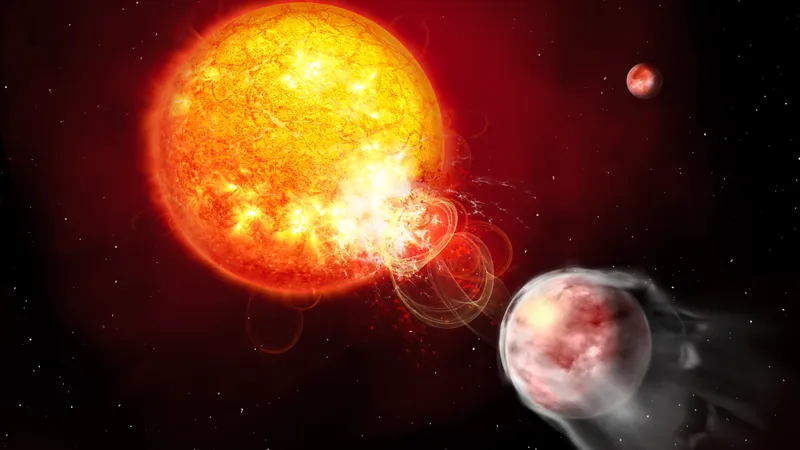
The Doomed Exoplanet: How Clingy Orbits Lead to Self-Destruction!
2025-07-02
Author: Wei Ling
Meet HIP 67522 b: The Planet on a Fast Track to Oblivion
In a shocking revelation, astronomers have discovered an exoplanet that epitomizes the phrase "you're your own worst enemy." Known as HIP 67522 b, this rebellious planet clings so tightly to its parent star that it’s triggering explosive outbursts, sealing its own fate.
A Year in a Week: The Astounding Orbit of HIP 67522 b
HIP 67522 b orbits a youthful star, just 17 million years old, completing a full orbit in a mere week—which is practically a blink of an eye in cosmic terms! In contrast, our own sun is a middle-aged 4.6 billion years old, meaning HIP 67522 is surrounded by a star that's brimming with energetic potential.
A New Frontier: The Interaction Between Stars and Their Planets
Since the mid-1990s, scientists have theorized about the close relationship between exoplanets and their stars, yet HIP 67522 b represents a groundbreaking discovery. Team leader Ekaterina Ilin from the Netherlands Institute for Radio Astronomy (ASTRON) stated, "We had never encountered a system like HIP 67522 before; this planet is the youngest known to orbit its star in less than 10 days. It raises so many questions about stellar interactions!"
TESS and Cheops: How We Found This Cosmic Conundrum
The discovery of HIP 67522 b came courtesy of NASA's TESS (Transiting Exoplanet Survey Satellite), which flagged intriguing activity surrounding this star. This led to further investigation with the European Space Agency’s Cheops mission, capable of pinpointing individual stars with extreme accuracy. The results were astonishing—15 stellar flares observed, almost all occurring as the planet transited in front of its star.
Flare-Up: The Planet's Role in Stellar Explosions
The flares emitted by the star during these transits were found to be connected to the planet itself, suggesting that HIP 67522 b is exerting a magnetic influence that triggers these explosive events. Ilin shared, "The waves generated by the planet travel down the star's magnetic field lines, resulting in massive flares. It’s like the planet is a catalyst for these eruptions!"
Radiation Overload: A Recipe for Doom
The implications for HIP 67522 b are dire. Positioned dangerously close to its star, it's bombarded by radiation six times greater than what would normally be expected at such an orbital distance. As a consequence, this Jupiter-sized planet, now as fluffy as cotton candy, is shedding its outer layers, gradually losing mass and density.
What Lies Ahead for HIP 67522 b?
Predictions suggest that in 100 million years, HIP 67522 b could shrink from a Jupiter-like mass to something more akin to Neptune—a significant loss! Ilin emphasized the importance of following up on this discovery: "We need to observe it in various wavelengths to assess the energy released in these flares. Uncovering other similar star-planet systems is crucial for understanding this phenomenon on a broader scale."
The Cosmic Lesson of HIP 67522 b
This captivating exploration of HIP 67522 b not only sheds light on the potential dangers of extreme proximity to a star but also opens a new chapter in our understanding of cosmic relationships. Will the mysteries of other star-planet systems soon unfold? Only time will tell!



 Brasil (PT)
Brasil (PT)
 Canada (EN)
Canada (EN)
 Chile (ES)
Chile (ES)
 Česko (CS)
Česko (CS)
 대한민국 (KO)
대한민국 (KO)
 España (ES)
España (ES)
 France (FR)
France (FR)
 Hong Kong (EN)
Hong Kong (EN)
 Italia (IT)
Italia (IT)
 日本 (JA)
日本 (JA)
 Magyarország (HU)
Magyarország (HU)
 Norge (NO)
Norge (NO)
 Polska (PL)
Polska (PL)
 Schweiz (DE)
Schweiz (DE)
 Singapore (EN)
Singapore (EN)
 Sverige (SV)
Sverige (SV)
 Suomi (FI)
Suomi (FI)
 Türkiye (TR)
Türkiye (TR)
 الإمارات العربية المتحدة (AR)
الإمارات العربية المتحدة (AR)